Mario Cipollini: The wounded Lion King
Shadows surround the former sprinter

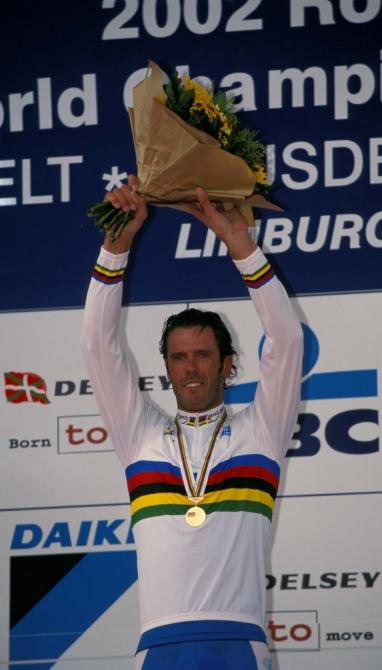
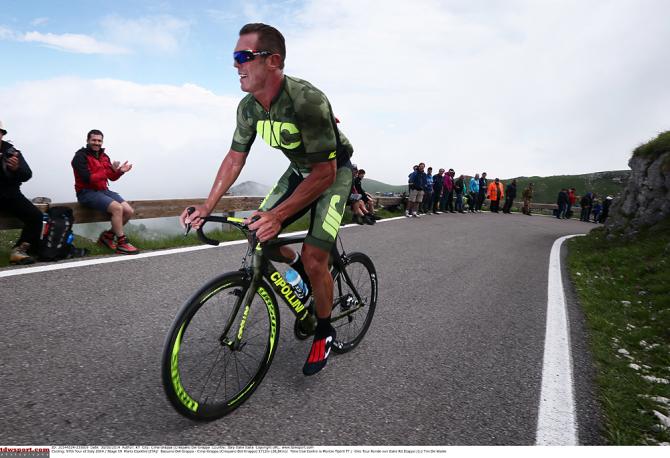

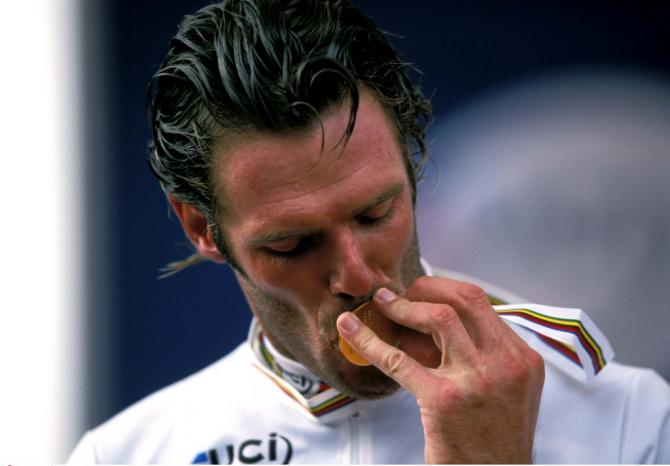


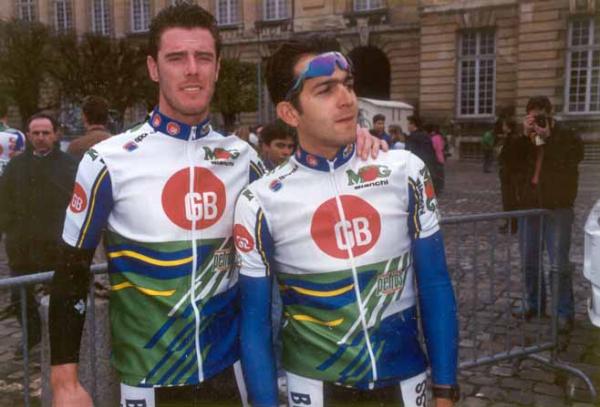
This feature appeared in the October issue of Procycling.
Even after Vincenzo Nibali’s Tour de France victory, Mario Cipollini is still arguably the most famous and popular former or current cyclist in Italy. This despite shadows over his legacy that the flamboyant ex-sprinter would like us to ignore.
Once upon a time, Mario Cipollini would travel to Tour de France start-lines in a roman chariot, dressed as Julius Caesar, or chased by a pride of pantomime lions. That was when he was a rider - and of course Cipollini, infamously, never made it to the Champs Elysées during a career that yielded 191 victories, including a record 42 Giro stages and 12 in the Tour. So perhaps the unfamiliarity of the surroundings explains why he cut such a sheepish figure, lurking not far from the Arc de Triomphe on the final day of the 2014 Grande Boucle, not a laurel wreath or toga in sight.
Alternatively, more probably, since a report in La Gazzetta dello Sport in February 2013 alleging that Dr Eufemiano Fuentes counted Cipollini among his clients, the 47-year-old has been as confused as the rest of us about where he stands in the professional cycling firmament. It’s understandable - certainly when state broadcaster RAI considers him a suitable guest for their post-stage analysis shows at the Giro, and La Gazzetta’s reporters on the race are so incensed that they refuse to appear on the same programmes; or when the Italian Olympic Committee (CONI) announces in the wake of the Fuentes revelations that they will launch a doping enquiry, yet a year later they officially rubber-stamp a granfondo that takes Cipollini’s name. La Gazzetta’s Ciro Scognamiglio sums up the schizophrenia thus: “The average Italian doesn’t really care what we wrote. But, for a journalist, it’s pretty hard to ignore….”

La Gazzetta’s
The evidence therefore seemed alarmingly persuasive - and yet within a matter of days the story had fizzled away. CONI requested the relevant paperwork from the Spanish authorities - then did precisely nothing. In May 2013, Cipollini dropped in on the Giro as a guest of the Vini Fantini team, figure-hugging white shirt unbuttoned almost to his midriff, jacket slung over his shoulder, hair embalmed in gel. He told journalist Marco Bonarrigo “the fans love me more than ever”, having already warned that he now catalogued reporters in “a black and a white list”. The clear implication was that those quizzing him about Fuentes belonged on the former. “At this point we’re proud to claim our position on the blacklist,” Bonarrigo wrote. He also pointed out that Cipollini and his legal team had apparently begun no legal action against La Gazzetta over their claims.
A year later, Cipollini was critiquing sprint trains and training methods on RAI’s Processo alla Tappa, at the Italian taxpayer’s expense. Off air, though, the defiance was as transparent as some of his more risqué skinsuits. And in July, at end of the Tour, he seemed a hesitant, almost nervous visitor to a venue, the Champs Elysées, that he had never graced as a rider.
The latest race content, interviews, features, reviews and expert buying guides, direct to your inbox!
Cipollini's Legacy
The question of Cipollini’s standing and legacy is, then, barely less complicated than assessing Lance Armstrong. Up to February 2013, he was unanimously hailed as one of the greatest sprinters of all time, if not the very best. Those 191 victories stood as testament to a dominance in bunch finishes that spanned most of the 1990s and to a large degree redefined an art; it would be wrong to suggest that Cipollini invented the “sprint train” but accurate to state the no one before him - not Rik Van Looy, not Jean Paul Van Poppel - had given the mechanism such emphasis or precision.
Equally important, Cipollini’s status as one of professional cycling and indeed professional sport’s greatest showmen was secure. The togas, the non-regulation shorts, the naked ad campaigns, the naked Pamela Anderson pictures on his handlebar stem, the naked tryst with glamour model Magda Gomes on a beach in Sardinia in 2006, caught on camera by a paparazzo… With Cipollini, there was barely a dull or fully-clothed moment.
Born in March 1967 in San Giusto di Compito, at the foot of Tuscan training mecca Monte Serra, he had been introduced to cycling by his father, a lorry driver and successful former amateur, and his brother, Cesare, who would turn professional in 1978. His sister, Tiziana, also raced. Cipollini’s speed immediately made him the scourge of local juniors: he won all but two of 19 races in his first season, at age seven. It would have been 19 out of 19, but he was stripped (for once, not in that way) of his first victory having broken a rule on gear ratios, and he lost out to a fellow future pro, Stefano della Santa, in another having seen his shadow on the road and got scared. In all, he would amass 125 bouquets in age-group and amateur races before turning pro with Del Tongo in 1989.
At school, his teachers complained that Cipollini was clever but bone idle or distracted. At home, he wreaked chaos. Aged six, he found the keys to his mum’s Fiat 500 and took it for a spin around the family house in San Giusto di Compito. A few years later, the manager of the Gis team, Piero Pieroni, visited the Cipollini’s to negotiate Cesare’s first pro contract. Pierini remembers Mario being so hyperactive that his parents had to tie him to an olive tree.
Before long, Cesare would be warning his contemporaries: “Win as much as you can now, because when my brother turns pro, you won’t get a look in.” Sure enough, in his debut season in the senior ranks, Cipollini would take the first of his 42 Giro stages and a hat-trick of wins at the Giro di Puglia. A shoulder-length mane of golden, ringlet curls already made him one of the more distinctive riders in the peloton. But he was also one of the strongest: in his second pro season, he made it two Giro stage wins, then three in his third year, and four in his fourth. In 1992 and 1993, he also rattled off consecutive victories in Gent-Wevelgem. It was also around this time that, by virtue of his hairstyle, Cipollini earned one of his more memorable sobriquets: “Mousselini”.
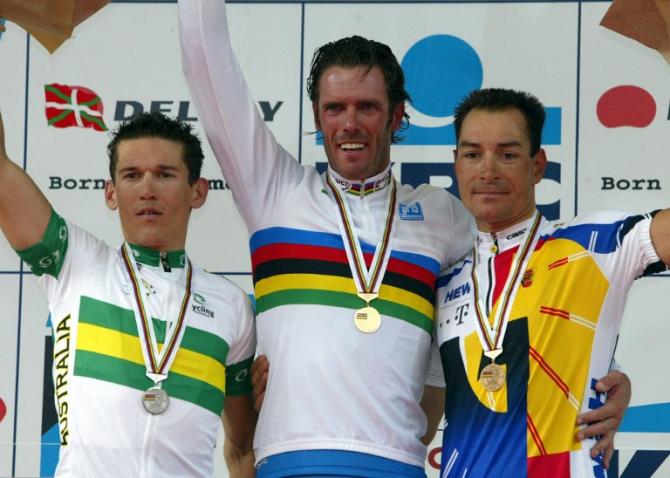
Already a renowned “sciupafemmine” or “ladykiller”, he married Sabrina Landucci, the sister of a famous football goalkeeper, in 1993 (they would separate in 2005). This was also the year of his first stage win in the Tour de France, at Les Sables d’Olonne. The Grande Boucle, though, was the one event whose dimensions could dwarf and unnerve even Cipollini. Midway through the 1995, as the Alps loomed, he’d be cranking up the air conditioning in his room in the hope of making himself ill and justifying an early withdrawal. It worked….sort of: his room-mate and lead-out man, Silvio Martinello, was soon coming down with fever, but not Cipollini. He didn’t care: when Martinello ripped off his race number midway through the next day’s stage, “Supermario” joined him in the broom wagon.
At this point, the mid-1990s, Cipollini was about to enter his pomp - the era of his “Treno Rosso” or “Red Train” at the Saeco team. As individuals, riders like Paolo Fornaciari, Giusppe Calcaterra, Gianmatteo Fagnini and Mario Scirea were no more than honest yeoman; together, they gelled into a formidably smooth and powerful cavalry, capable of delivering their leader at astonishing speeds. They arguably reached the pinnacle of their craft at the 1997 Giro, where Cipollini claimed five stages. Another Saeco rider, Ivan Gotti, took the pink jersey that year. Surveying a weary, listless roomful of reporters at the team’s end-of-race press conference, Cipollini rose up off his chair, arms spread in exasperation. “What the hell is this? Are we at a funeral or something?” He then tried to lighten the mood, telling the journalists: “You have to cheer up a bit. Come on, forza, tomorrow we’re all going home after a month away. And do you know what the second thing us riders do when we get home is? We put our suitcases down….”
A darker side
With the press, team-mates and opponents, Cipollini could be warm and lavishly generous or savagely cruel. In stage five of the 2000 Vuelta, the Spaniard Francisco Cerezo rode away from a frank exchange of views with the “Lion King” nursing a black eye. Cipollini was sent home in disgrace - conveniently for him, before the Pyrenees. Four years later, one morning early in the 2004 Giro, he invited the suave, softly-spoken Tuttosport correspondent, Beppe Conti, onto the Domina Vacanze team bus for a chat about his account of the previous day’s sprint. The discussion quickly turned into an altercation - and Conti would consider himself lucky to escape unharmed.
“He could be brutal,” says Stefano Zanatta, one of the directeurs sportifs charged with taming the beast in his brief, pre-retirement cameo at Liquigas in 2005. “He would scream at people if they didn’t do what he wanted, humiliate them, belittle them. I can remember a training camp we did in South Africa before that 2005 season. There were three neo-pros on the trip, and by the end of the first training ride he’d changed their saddle height, their pedalling style, their training regime… Then there was one morning at Tirreno-Adriatico when one of the domestiques, Mauro Gerosa, sat in the front seat of the team car before we left for the start. The front seat was always Mario’s seat. He opened the door, glared at Gerosa and said, ‘How many professional races have you won?’ Then he almost literally kicked him out of the car…”
If, often, he tormented in jest, there was also a more sinister side to his personality, times when he confused the role of alpha male with the acts of a bully. In 2004, for example, he lobbied for Filippo Simeoni to be left out of the Domina Vacanze Tour team because Simeoni had testified in court that Cipollini’s sometime coach, Dr Michele Ferrari, had advised him on doping. In common with his friend Lance Armstrong, Cipollini could indeed be less “patron” of the peloton than “padrino” - the godfather.
His boorishness also extended to interviews. Sometimes it was funny or at least harmless, like when he told a Spanish journalist in 1993, “An orgasm only lasts for a few seconds, a victory lasts forever” - a soundbite that could also be his epitaph. But there have been other occasions when Cipollini’s disregard for political correctness has reflected the same lack of judgment and self-awareness that now leads him to believe that he is more popular than ever in Italy. Call it Berlusconi syndrome; the former Italian prime minister certainly came to mind when, in 2012, Cipollini complained that present-day riders weren’t…virile enough: “Contador and Schleck congratulating each other by giving each other a little tap on the top of the Tourmalet. You’d think they were a pair of gays….When you used to look at Hinault, you saw a good-looking bloke. Indurain, fuck, he was handsome. Strong men. Merckx, bloody hell, he was like an actor… Now, look at Schleck, look at Contador. They’re extraordinary athletes, but come on. They’re small, skinny, light, like a pair of show ponies.”
Or when, in an interview with French magazine Pédale, he put the issue of doping in sport into the following nutshell: “I think that Chinese communism forced the world of sport to say: ‘This competition has to be perfect. We mustn’t have any kind of problem.’”
Or when, in the same article, he called Armstrong “a genius”.
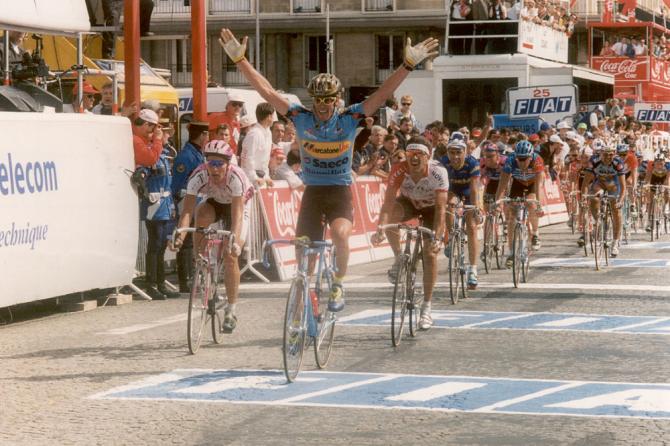
These days we’re generally spared such pearls of wisdom, largely because, like Marco Bonarrigo, most journalists have given up on Cipollini. He has thus far resolutely refused to broach the doping allegations. Bonarrigo observes, “In Italy, the best way of responding to accusations, even very serious ones, has always been not to respond.” If this is true, then Cipollini cannot be faulted.
His lawyer responds
But his lawyer, Giuseppe Napoleone, also assured Procycling in August that the day of reckoning will soon arrive: Napoleone says that not only did CONI never open an investigation into La Gazzetta’s allegations, but that he is currently preparing a libel case against La Gazzetta. “CONI had those documents in 2006 and did nothing with them. That’s because Mario Cipollini had nothing to do with it,” he affirmed.
This controversy aside, Cipollini occasionally still makes headlines or dispatches columns, on the sports pages and otherwise. After his short-lived comeback in 2008 with a fellow agent provocateur, fashion mogul Michael Ball and his Rock Racing team, he briefly threatened another encore with the Farnese Vini outfit that raced on “Cipollini” branded bikes in 2012. There was just one problem: they didn’t want him.
If that rejection hurt his pride, some had been restored in 2010 when a one year, ten month suspended prison sentence for tax evasion was overturned on appeal. That was barely reported, unlike the cycling accident which this August cost him a smashed left kneecap and operation. All being well, he’ll be back on his bike, no doubt as tanned and sculpted as ever, before the end of the year.
Friends say that his lifestyle in recent years has been less hedonistic than his enduring playboy image would suggest. He rides bikes, tests them for his Cipollini brand, visits a gym, and often wanders over to the SRM service centre across the street from his villa in Lucca to shoot the breeze, drink coffee, hang out. He regularly checks in on his mother in San Giusto di Compito. His father, Vivaldo, died in 2010. Cipollini maintains that the cycling accident that left Vivaldo badly brain-damaged in 1999 inspired his own world championship victory in Zolder three years later.
Vivaldo was, apparently, a hard man to please. He used to tell Mario that sprinting was a waste of his talent. But Cipollini went his own way. As he said a couple of years ago, “I was a leopard. And you don’t ask a leopard to be a cow.”
Neither do you ask him to change his spots. At some point, Mario, nonetheless, you’ve got a bit of explaining to do.
This feature appeared in the October issue of Procycling.